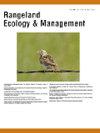Nutritional Dynamics of Plant Growth Forms in a Forest-Grassland Mosaic
IF 2.4
3区 环境科学与生态学
Q2 ECOLOGY
引用次数: 0
Abstract
The objectives of this study were to determine the influence of plant community type, forest stand age, and season on the forage quality of plant growth forms in a forest-grassland mosaic. We determined the forage quality of plant growth forms (graminoids, forbs, and shrubs) at 64 sites in the Blue Mountains of Oregon, over four dates between May and September over two years. Samples were analyzed for crude protein (CP), acid detergent fiber (ADF), and neutral detergent fiber (NDF). Sites were classified according to climax vegetation and grouped as either forested (ponderosa pine, Pinus ponderosa; Douglas-fir, Pseudotsuga menziesii; grand fir, Abies grandis) or non-forested (meadow or grassland). Forested sites were also categorized as “young” or “old” based on mean diameter at breast height of less than or greater than 37.5 cm, respectively. Graminoid and forb CP in early May were 3.5 and 2.5 points greater in the grand fir community type than the other forested types (P ≤ 0.01) and were 2.7 and 4.9 points greater in the meadow type than the grassland type (P ≤ 0.04). In mid-September, graminoid CP was similar between all community types (P ≥ 0.78). In early May, forb ADF and NDF were similar between all community types (P ≥ 0.18). In mid-September, forb ADF was 10.7 points lower in the ponderosa pine and Douglas-fir types than in all other community types (P ≤ 0.02). Forb ADF and NDF were greater in young stands than in old stands (P < 0.01). Furthermore, forb ADF was 11.4 points greater in the young grand fir community type than all other forested types (P < 0.01). Our study characterizes forage quality across the growing season in diverse vegetation types and, in turn, can be applied to wildlife and livestock management to predict and manage animal landscape distribution.
森林-草地嵌合体中植物生长形态的营养动态
本研究的目的是确定植物群落类型、林龄和季节对森林-草地嵌合植物生长形式的饲料质量的影响。在两年多的时间里,我们在俄勒冈州蓝山的64个地点测定了植物生长形式(禾本科植物、牧草和灌木)的饲料质量。测定样品的粗蛋白质(CP)、酸性洗涤纤维(ADF)和中性洗涤纤维(NDF)。根据顶极植被对样地进行分类,分为有森林的黄松、黄松;孟氏伪杉木;大冷杉,大冷杉)或非森林(草甸或草地)。森林立地也根据胸径小于或大于37.5 cm的平均直径分别被分类为“年轻”或“老”。5月初,大冷杉群落类型禾本科和牧草CP分别比其他林分类型高3.5和2.5点(P ≤ 0.01),草甸群落类型禾本科和牧草CP分别比草地类型高2.7和4.9点(P ≤ 0.04)。9月中旬,各群落类型间禾本科蛋白CP相似(P ≥ 0.78)。5月初,各群落类型间牧草ADF和NDF基本一致(P ≥ 0.18)。9月中旬,黄松和道格拉斯冷杉两种群落类型的牧草ADF比其他所有群落类型低10.7点(P ≤ 0.02)。幼龄林分Forb ADF和NDF高于老龄林分(P <; 0.01)。幼杉木群落类型的牧草ADF比其他林分类型高11.4分(P <; 0.01)。我们的研究描述了不同植被类型下牧草生长季节的质量特征,进而可以应用于野生动物和牲畜管理,以预测和管理动物景观分布。
本文章由计算机程序翻译,如有差异,请以英文原文为准。
求助全文
约1分钟内获得全文
求助全文
来源期刊

Rangeland Ecology & Management
农林科学-环境科学
CiteScore
4.60
自引率
13.00%
发文量
87
审稿时长
12-24 weeks
期刊介绍:
Rangeland Ecology & Management publishes all topics-including ecology, management, socioeconomic and policy-pertaining to global rangelands. The journal''s mission is to inform academics, ecosystem managers and policy makers of science-based information to promote sound rangeland stewardship. Author submissions are published in five manuscript categories: original research papers, high-profile forum topics, concept syntheses, as well as research and technical notes.
Rangelands represent approximately 50% of the Earth''s land area and provision multiple ecosystem services for large human populations. This expansive and diverse land area functions as coupled human-ecological systems. Knowledge of both social and biophysical system components and their interactions represent the foundation for informed rangeland stewardship. Rangeland Ecology & Management uniquely integrates information from multiple system components to address current and pending challenges confronting global rangelands.
 求助内容:
求助内容: 应助结果提醒方式:
应助结果提醒方式:


